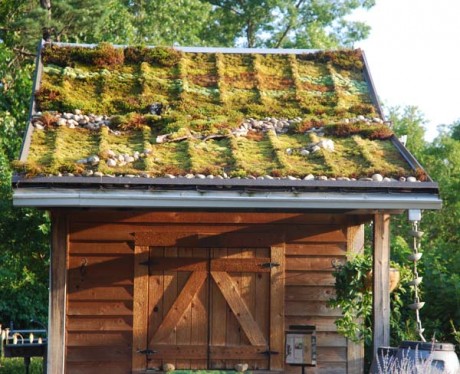A colorful roof for all seasons
Native mosses on this roof tolerate full sun, weather extremes and control storm water runoff
Cool and green describe the new Moss Green Roof at the North Carolina Arboretum located in Asheville. It shows how indigenous mosses can achieve year-round green beauty as well as how mosses tolerate full sun exposure.
Sun mosses, not shade mosses, are featured in this roof, designed to imitate a western North Carolina mountain landscape. In addition, rainwater is employed for a misting irrigation system to keep the mosses lush.
Annie Martin, known as Mossin' Annie, an environmental moss artist/landscaper and owner of Mountain Moss in Pisgah Forest, spearheaded the roof project.
Green roofs reduce the heat index of a building and provide storm water runoff solutions, Annie Martin says. "For most green roofs, sedums are usually the plants of choice. However, since mosses already grow on roofs in our mountain region, it makes sense to intentionally choose indigenous mosses as a horticultural preference."
The demonstration green roof is on the garden shed located just outside the Baker Education Center at the arboretum.
Utilizing bryophytes (mosses) that like direct sun exposure, Mountain Moss transformed a bright tin roof into a verdant expanse of moss art. With various shades of green and textures, the mosses will provide additional color with brilliant reds, golds and bronzes when in sporophytic reproductive stage. When other garden plants are dormant or dead, the mosses will keep on producing, even in winter months.
Planted during the summer heat wave while temperatures were in the high 90s, the Moss Green Roof has been subjected to the stresses of extreme weather conditions. Yet, despite heat, torrential thunderstorms, high winds and hail, the mosses are intact and adjusting to their new abode. With botanical characteristics that enable mosses to tolerate all types of extremes, these miniature plants are hardy. In the winter when temperatures drop below freezing, the mosses will not only survive, but grow.
Another aspect of the green appeal of mosses is that these non-vascular plants provide solutions to environmental issues such as storm water runoff, water filtration and erosion control. Since mosses don't require any pesticides, herbicides or fertilizers, there will be no groundwater contamination.
Other Transylvania County residents involved in the production of the green roof included Joe Bruneau, 7 Arts Co-op Gallery director, and Eric Stephenson, owner of Rite Angle Builders. With minimal structural modifications necessary to prepare the roof, the team used EnkaDrain (produced by Colbond in Enka) as the primary substrate for planting. Kevin McRae of K2 Irrigation in Asheville connected the existing rain water cistern into a misting system for the mosses. Supplemental watering is a key factor in long-term success of any moss feature.
In keeping with the mission of arboretum to cultivate connections between people and plants through creative expressions of landscape stewardship, this moss green roof project promotes conservation and education. The product was funded by the North Carolina Arboretum Foundation Society.
-
Share this story:



